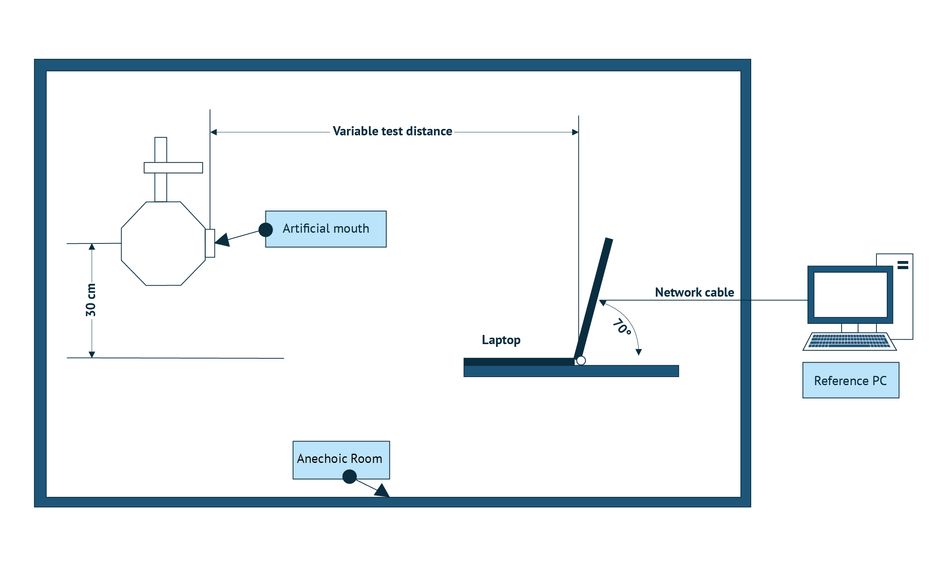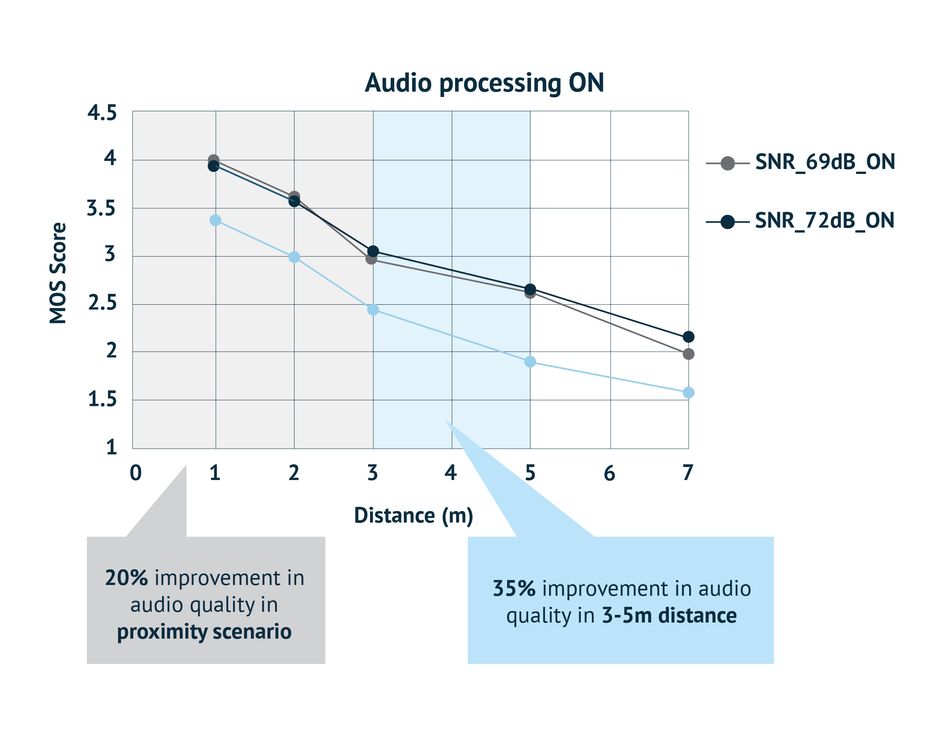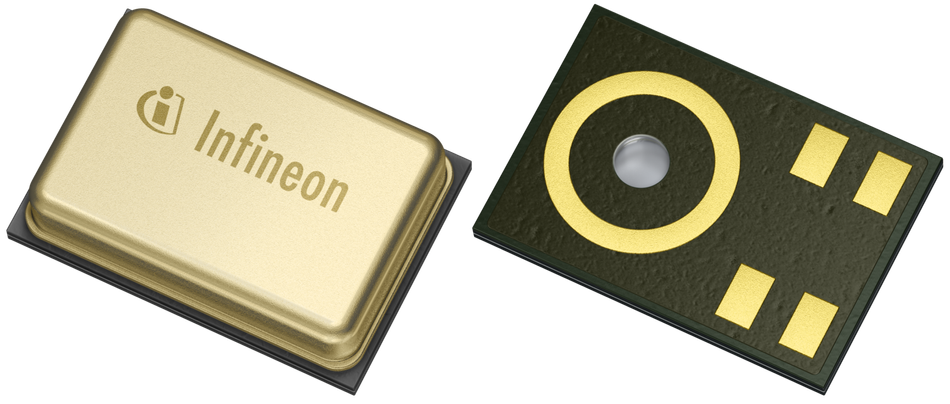High SNR microphones are transforming laptops into all-round communication hubs
Article #5 of the Enabling IoT Series. MEMS microphones can deliver high-quality sound in an ultra-small form-factor.
This is the fifth article in a 6-part series exploring the technologies enabling the cutting-edge IoT.
Large portions of the workforce continue to work from home or in hybrid models. Although some organizations are largely getting back to ‘normal’, many people have grown accustomed to meeting online. Without face-to-face meetings in the office, productive and efficient communication relies on good tools, from video conferencing software to computer hardware.
Two decades ago, few laptops contained built-in microphones. But now, almost every laptop on the market features a webcam and one or more microphone(s) – the essential tools for coworkers to collaborate when not all of the attendees are in the same room.
In this article, we look at the evolution of the laptop from a word processing tool to a studio-grade communication device and the tech behind it.
Microphones and webcams become ubiquitous
The introduction of microphones into laptops marked a shift for these machines from simple word processors and number crunching devices to communications platforms.
As more and more people abandoned desktops in favor of laptops, it became clear that consumers did not want to rely on external peripherals. To cater to the market, manufacturers worked on integrating peripherals into their laptops, reducing the need for peripheral devices to conduct specific tasks. Instead of an external USB hub, laptops got extra built-in USB ports. Instead of WiFi dongles, laptops got integrated wireless cards. Instead of mice, laptops got multi-touch trackpads.
And as high-speed internet became commonplace and enabled video calling, manufacturers began integrating webcams and microphones into the bezels of their laptops to meet the wave of online communication. Apple, for instance, first introduced a built-in camera and microphone with iSight on the original 15” MacBook Pro in 2006.1
At the end of the ‘00s, most performance-oriented laptop models contained similar hardware. By the ends of the ‘10s, virtually all laptops—down to the most budget-friendly models—included webcams and microphones.
High SNR microphones transform laptops to complete communication devices
The next upgrade of peripherals into laptops is on its way: high SNR microphones using MEMS technology. This technology push is expected to represent a change in the mindset of how we will use and work with our laptops.
The pandemic and other factors have shifted us from our offices to our homes, but the next generation of microphones allows us to stand up, walk around, to have multiple people talking to the same mic, all while having pristine sound and audio quality.
SNR
SNR is not a technology but a metric to assess the quality of a microphone. It stands for Signal to Noise Ratio. SNR is measured by the proportion of sound coming from your colleague (or other caller) compared to the noise that is accompanied by it, transmitted through their microphone. The other noise comes from multiple sources, among which is ambient noise, electromagnetic interference, and the mechanical vibrations from the microphone.
MEMS microphones
One of the core advantages of MEMS microphones is that they can be manufactured in large quantities on silicon wafers. In that sense, the manufacturing process is similar (but not the same) as microchip manufacturing. This method ensures low part-to-part deviation, meaning extremely reliable production flow.
Unlike conventional condenser based microphones, MEMS microphones majorly use capacitive sensing technology to translate air movements into digital signals. The MEMS sensing elements are combined with low-noise ASICs. Because of the use of micro-process technology MEMS microphones can be very small and therefore fit into sub 10mm² footprint packages.
Making a laptop a communication device: Case Study
In a recent experiment, technology company Infineon demonstrated the benefits of XENSIV™ MEMS microphones with high SNR for communication. The team designed a scenario using an artificial mouth with a variable distance to a laptop facing the mouth to receive the sound signal, as seen in Figure 1. The measurements were done at a system partner lab based in China.
At larger distances between 3 and 5 meters, the XENSIV™ MEMS microphone was hypothesized to deliver good results. Four different cases were tested: a laptop with a conventional microphone and one with a XENSIV™ MEMS microphone with high SNR, and both cases with and without Voice Signal Processing provided by VoIP services.
Comparing played-back speech captured by the microphones with the original file, it turned out that the high SNR XENSIV™ MEMS microphone performed better than a conventional laptop microphone in both cases. The real test to confirm that is to see whether the quality perception of the sound by people is also better. For that, they compared the Mean Opinion Score (MOS) of both microphones. As can be seen in Figure 2, their microphones achieved a 20% improvement in audio quality on a close range, between 1 and 3 meters, and 35% improvement in the conference scenario, between 3 and 5 meters!
From this test, we get a glimpse into the future of a more natural and studio-quality experience of using laptops as communication devices.
The future of MEMS microphones
Through their size, digital characteristics, and quality, MEMS microphones will enable us to move between conversations and devices seamlessly and even leave the traditional fixed position behind our desk. Imagine having a phone call with someone while you are walking from room to room. MEMS microphones with high SNR in each device will ensure a better sound pickup to enable algorithms to work better in spite of ambient noise and changing distances between you and the receiver.
Because of their ability to deliver studio-quality sound pickup, MEMS microphones may even be able to enable podcast-style audio without the need for external microphones etc.
The way we communicate both for work and entertainment is changing – with an increase in voice-based forms of communication, including calls, but also voice messaging, podcasts, and socializing apps like Clubhouse.
Beyond laptops, there are many applications for microphones in IoT devices. Voice-controlled voice assistants are commonplace, and voice-user interface has the potential to be applied in a host of other smart home devices. They are not just technological innovations; they represent a shift in the way we work and live.
Selecting an Infineon microphone
Infineon is one of the few microphone manufacturers able to deliver on the promise of high SNR MEMS microphones. They produce both MEMS microphones and ASICs (Application-Specific Integrated Circuits), as well as packaged microphones where both are integrated. They designed their XENSIVTM series of MEMS microphones for laptops and other devices with the intent of improving sound quality for communications
There are several models in the XENSIVTM lineup that are available now, as well as several new models that will hit the market soon.
When selecting a XENSIV microphone, one must first determine what interface their application requires. Infineon offers digital microphones with PDM (Pulse-Density Modulation) interface and analog microphones with differential as well as single-ended interface. Thereby they cover all the most commonly used interfaces in the market.
The choice of interface relies majorly on the front-end of the system SoC. Digital PDM models consume 980 µA—though a low-power 520 µA model (the IM69D128S) will launch soon. Analog differential interface models consume less power at 170 µA. The IM68A130 will consume a mere 110 µA.
Those requirements alone should narrow the Infineon XENSIV catalog down to a few options. From there, it is a matter of choosing the right balance of sensitivity, SNR, and the acoustic overload point (AOP) that suits your application.
Most of the models in the XENSIV catalog have sealed dual membrane (SDM) MEMS technology, which delivers an IP57 rating. That provides a high level of ingress protection from water and dust to help you design this microphone in your next product.
The first article explains why radar sensors are powerful enablers for intelligent IoT applications.
The second article provides a deep look at the role of Co2 sensors.
The third article looks at how Time of Flight (ToF) sensors are used for this purpose and are changing the way we can interact with VR, and other video technologies.
The forth article looks at how industrial enterprises are moving to a new approach to asset management, namely predictive maintenance by leveraging powerful new sensors and data.
About the sponsor: Infineon Technologies
Infineon Technologies AG is a world leader in semiconductor solutions that make life easier, safer and greener. Microelectronics from Infineon are the key to a better future. With around 50,280 employees worldwide, Infineon generated revenue of about €11.1 billion in the 2021 fiscal year (ending 30 September) and is one of the ten largest semiconductor companies worldwide. To learn more click here.
References
1. Apple. 15-inch MacBook Pro Developer Note. Developer Connection [Internet]. 2008 Oct 10. Available from: https://web.archive.org/web/20081010192847/http://developer.apple.com/documentation/HardwareDrivers/Conceptual/MacBookPro_0601/Articles/MacBookPro_0601.html
2. Mike Levine. The shape of things to come: Different types of microphones and when to use them. Popular Science [Internet]. 2022 Mar 6. Available from: https://www.popsci.com/reviews/types-of-microphones/
3. Infineon. MEMS microphones for consumer. Infineon [Internet]. Available from: https://www.infineon.com/cms/en/product/sensor/mems-microphones/mems-microphones-for-consumer/
4. mynewmicrophone.com. What Is A Good Signal-To-Noise Ratio For A Microphone? [Internet]. Available from: https://mynewmicrophone.com/what-is-a-good-signal-to-noise-ratio-for-a-microphone/
5. mynewmicrophone.com. What Is A MEMS Microphone? (Micro-Electro-Mechanical Systems). [Internet]. Available from: https://mynewmicrophone.com/what-is-a-mems-micro-electro-mechanical-systems-microphone/
6. EE times.com. How Excellent MEMS Microphones Turn Laptops into Communication Systems. [Internet]. Available from: https://www.eetimes.com/how-excellent-mems-microphones-turn-laptops-into-communication-systems/





